Investigation of the Gamma-ray Shielding Performance of CuO-CdO-Bi2O3 Bentonite Ceramics
Abstract
:1. Introduction
2. Materials and Methods
2.1. Sample Preparation
2.2. SEM Test
2.3. Photon Attenuation Test
3. Results and Discussion
4. Conclusions
Author Contributions
Funding
Institutional Review Board Statement
Informed Consent Statement
Data Availability Statement
Acknowledgments
Conflicts of Interest
References
- Hu, G.; Hu, H.; Yang, Q.; Yu, B.; Sun, W. Study on the design and experimental verification of multilayer radiation shield against mixed neutrons and γ-rays. Nucl. Eng. Technol. 2020, 52, 178–184. [Google Scholar] [CrossRef]
- Hernandez-Murillo, C.G.; Contreras, J.R.M.; Escalera-Velasco, L.A.; de Leon-Martínez, H.A.; Vega-Carrillo, H.R. X-ray and gamma ray shielding behavior of concrete blocks. Nucl. Eng. Technol. 2020, 52, 1792–1797. [Google Scholar] [CrossRef]
- Dong, M.; Xue, X.; Yang, H.; Li, Z. Highly Cost-effective shielding composite made from vanadium slag and boron-rich slag and its properties. Radiat. Phys. Chem. 2017, 141, 239–244. [Google Scholar] [CrossRef]
- Dong, M.; Xue, X.; Yang, H.; Liu, D.; Wang, C.; Li, Z. A novel comprehensive utilization of vanadium slag: As gamma-ray shielding material. J. Hazard. Mater. 2016, 318, 751–757. [Google Scholar] [CrossRef] [PubMed]
- Gökç, H.S.; Canbaz-Öztürk, B.; Çam, N.F.; Andiç-Çakır, Ö. Gamma-ray attenuation coefficients and transmission thickness of high consistency heavyweight concrete containing mineral admixture. Cem. Concr. Compos. 2018, 92, 56–69. [Google Scholar] [CrossRef]
- More, C.V.; Bhosale, R.R.; Pawar, P.P. Detection of new polymer materials as gamma-ray-shielding materials, Radiation Effects and Defects in Solids. Inc. Plasma Sci. Plasma Technol. 2017, 172, 469–484. [Google Scholar]
- Levet, A.; Kavaz, E.; Ozdemir, Y. An experimental study on the investigation of nuclear radiation shielding characteristics in iron-boron alloys. J. Alloy. Compd. 2020, 819, 152946. [Google Scholar] [CrossRef]
- Wagh, A.S.; Sayenko, S.Y.; Dovbnya, A.; Shkuropatenko, V.; Tarasov, R.; Rybka, A.; Zakharchenko, A. Durability and shielding performance of borated ceramicrete coatings in beta and gamma radiation fields. J. Nucl. Mater. 2015, 462, 165–172. [Google Scholar] [CrossRef]
- Dong, M.; Zhou, S.; Xue, X.; Feng, X.; Yang, H.; Sayyed, M.I.; Tishkevich, D.; Trukhanov, A.; Almous, N. Upcycling of boron bearing blast furnace slag as highly cost-effective shield for protection of neutron radiation hazard: An innovative way and proposal of shielding mechanism. J. Clean. Prod. 2022, 355, 131817. [Google Scholar] [CrossRef]
- Issa, S.A.M.; Sayyed, M.I.; Zaid, M.H.M.; Matori, K.A. Photon parameters for gamma-rays sensing properties of some oxide of Lanthanides. Results Phys. 2018, 9, 206–210. [Google Scholar] [CrossRef]
- Jawad, A.A.; Demirkol, N.; Gunoğlu, K.; Akkurt, I. Radiation shielding properties of some ceramic wasted samples. Int. J. Environ. Sci. Technol. 2019, 16, 5039–5042. [Google Scholar] [CrossRef]
- Amritphale, S.S.; Anshul, A.; Chandra, N.; Ramakrishnan, N. Development of celsian ceramics from fly ash useful for X-ray radiation-shielding application. J. Eur. Ceram. Soc. 2007, 27, 4639–4647. [Google Scholar] [CrossRef]
- Iacob, M.; Tiron, V.; Stiubianu, G.; Dascalu, M.; Hernandez, L.; Varganici, D.; Tugui, C.; Cazacu, M. Bentonite as an active natural filler for silicone leading to piezoelectric-like response material. J. Mater. Res. Technol. 2022, 17, 79–94. [Google Scholar] [CrossRef]
- Popov, A.I.; Lushchik, A.; Shablonin, E.; Vasil’chenko, E.; Kotomin, E.A.; Moskina, A.M.; Kuzovkov, V.N. Comparison of the F-type center thermal annealing in heavy-ion and neutron irradiated Al2O3 single crystals. Nucl. Instrum. Methods Phys. Res. Sect. B Beam Interact. Mater. At. 2018, 433, 93–97. [Google Scholar] [CrossRef]
- Arshak, K.; Corcoran, J.; Korostynska, O. Gamma radiation sensing properties of TiO2, ZnO, CuO and CdO thick film pn-junctions. Sens. Actuators A Phys. 2005, 123, 194–198. [Google Scholar] [CrossRef]
- Luchechko, A.; Vasyltsiv, V.; Kostyk, L.; Tsvetkova, O.; Popov, A.I. Shallow and deep trap levels in X-ray irradiated β-Ga2O3: Mg. Nucl. Instrum. Methods Phys. Res. Sect. B Beam Interact. Mater. At. 2009, 441, 12–17. [Google Scholar] [CrossRef]
- Bellucci, S.; Bolesta, I.; Guidi, M.C.; Karbovnyk, I.; Lesivciv, V.; Micciulla, F.; Pastore, R.; Popov, A.I.; Velgosh, S. Cadmium clusters in CdI2 layered crystals: The influence on the optical properties. J. Phys. Condens. Matter. 2007, 19, 395015. [Google Scholar] [CrossRef] [Green Version]
- Asal, S.; Erenturk, S.A.; Haciyakupoglu, S. Bentonite-based ceramic materials from a perspective of gamma-ray shielding: Preparation, characterization and performance evaluation. Nucl. Eng. Technol. 2021, 53, 1634–1641. [Google Scholar] [CrossRef]
- Oto, B.; Kavaz, E.; Durak, H.; Aras, A.; Madak, Z. Effect of addition of molybdenum on photon and fast neutron radiation shielding properties in ceramics. Ceram. Int. 2019, 45, 23681–23689. [Google Scholar] [CrossRef]
- Usta, M.; Karahan, I.H. Effect of current density on structural and radiation shielding characteristics of NiCoB/hBN composites. Radiat. Phys. Chem. 2022, 194, 110027. [Google Scholar] [CrossRef]
- Sayyed, M.I.; Hannachi, E.; Slimani, Y.; Khandaker, M.U.; Elsafi, M. Radiation shielding properties of bi-ferroic ceramics added with CNTs. Adiation Phys. Chem. 2022; in press. [Google Scholar] [CrossRef]
- Hannachi, E.; Mahmoud, K.A.; Sayyed, M.I.; Slimani, Y. Structure optical properties, and ionizing radiation shielding performance using Monte Carlo simulation for lead-free BTO perovskite ceramics doped with ZnO, SiO2, and WO3 oxides. Mater. Sci. Semicond. Processing 2022, 145, 106629. [Google Scholar] [CrossRef]
- Temir, A.; Zhumadilov, K.; Zdorovets, M.; Kozlovskiy, A.; Trukhanov, A. Study of gamma radiation shielding efficiency with radiation-resistant Bi2O3-TeO2-WO3 ceramics. Solid-State Sci. 2021, 115, 106604. [Google Scholar] [CrossRef]
- Sivakumar, S.; Teow, H.L.; Satesh, N.; Hosseini, M.F.; Yong, E.S. The Effect of Copper Oxide on the Mechanical Properties of Y-TZP Ceramics. J. Phys. Conf. Ser. 2020, 1532, 12002. [Google Scholar] [CrossRef]
- Al-Ghamdi, H.; Sayyed, M.I.; Elsafi, M.; Kumar, A.; Al-Harbi, N.; Almuqrin, A.H.; Yasmin, S.; Khandaker, M.U. An experimental study measuring the photon attenuation features of the P2O5–CaO–K2O–Na2O–PbO glass system. Radiat. Phys. Chem. 2022; in press. [Google Scholar]
- Sayyed, M.I.; Hamad, M.K.; Mhareb, M.H.A.; Kurtulus, R.; Dwaikat, N.; Saleh, M.; Elsafi, M.; Taki, M.M.; Kavas, T.; Ziq, K.A.; et al. Assessment of radiation attenuation properties for novel alloys: An experimental approach. Radiat. Phys. Chem. 2022; in press. [Google Scholar]
- Almuqrin, A.H.; Sayyed, M.I.; Elsafi, M.; Khandaker, M.U. Comparison of radiation shielding ability of Bi2O3 micro and nanoparticles for radiation shields. Radiat. Phys. Chem. 2022; in press. [Google Scholar]
- Aloraini, D.A.; Sayyed, M.I.; Mahmoud, K.A.; Almuqrin, A.A.H.; Kumar, A.; Khandaker, M.U.; Elsafi, M. Evaluation of radiation shielding characteristics of B2O3–K2O–Li2O-HMO (HMO = TeO2/SrO/PbO/Bi2O3) glass system: A simulation study using MCNP5 code. Radiat. Phys. Chem. 2022; in press. [Google Scholar]
- Al-Harbi, N.; Sayyed, M.I.; Al-Hadeethi, Y.; Kumar, A.; Elsafi, M.; Mahmoud, K.A.; Khandaker, M.U.; Bradley, D.A. A novel CaO–K2O–Na2O–P2O5 glass systems for radiation shielding applications. Radiat. Phys. Chem. 2021, 188, 109645. [Google Scholar] [CrossRef]
- D’Souza, A.N.; Sayyed, M.I.; Karunakara, N.; Al-Ghamdi, H.; Almuqrin, A.H.; Elsafi, M.; Khandaker, M.U.; Kamath, S.D. TeO2 SiO2–B2O3 glasses doped with CeO2 for gamma radiation shielding and dosimetry application. Radiat. Phys. Chem. 2022; in press. [Google Scholar]
- Sayyed, M.I.; Alrashedi, M.F.; Almuqrin, A.H.; Elsafi, M. Recycling and optimizing waste lab glass with Bi2O3 nanoparticles to use as a transparent shield for photons. J. Mater. Res. Technol. 2022, 17, 2073–2083. [Google Scholar] [CrossRef]
- Al-Hadeethi, Y.; Sayyed, M.I.; Barasheed, A.Z.; Ahmed, M.; Elsafi, M. Preparation and radiation attenuation properties of ceramic ball clay enhanced with micro and nano ZnO particles. J. Mater. Res. Technol. 2022, 17, 223–233. [Google Scholar] [CrossRef]
- Hannachi, E.; Sayyed, M.I.; Slimani, Y.; Elsafi, M. Experimental investigation on the physical properties and radiation shielding efficiency of YBa2Cu3Oy/M@M3O4 (M = Co, Mn) ceramic composites. J. Alloy. Compd. 2022, 904, 164056. [Google Scholar] [CrossRef]
- Al-Hadeethi, Y.; Sayyed, M.I.; Barasheed, A.Z.; Ahmed, M.; Elsafi, M. Fabrication of Lead Free Borate Glasses Modified by Bismuth Oxide for Gamma Ray Protection Applications. Materials 2022, 15, 789. [Google Scholar] [CrossRef] [PubMed]
- Hannachi, E.; Sayyed, M.I.; Slimani, Y.; Almessiere, M.A.; Baykal, A.; Elsafi, M. Synthesis, characterization, and performance assessment of new composite ceramics towards radiation shielding applications. J. Alloy. Compd. 2022, 899, 163173. [Google Scholar] [CrossRef]
- Elsafi, M.; Koraim, Y.; Almurayshid, M.; Almasoud, F.I.; Sayyed, M.I.; Saleh, I.H. Investigation of Photon Radiation Attenuation Capability of Different Clay Materials. Materials 2021, 14, 6702. [Google Scholar] [CrossRef] [PubMed]
- Aloraini, D.A.; Almuqrin, A.H.; Sayyed, M.I.; Al-Ghamdi, H.; Kumar, A.; Elsafi, M. Experimental Investigation of Radiation Shielding Competence of Bi2O3-CaO-K2O-Na2O-P2O5 Glass Systems. Materials 2021, 14, 5061. [Google Scholar] [CrossRef] [PubMed]
- Elsafi, M.; Alrashedi, M.F.; Sayyed, M.I.; Al-Hamarneh, I.F.; El-Nahal, M.A.; El-Khatib, M.; Khandaker, M.U.; Osman, H.; Askary, A.E. The Potentials of Egyptian and Indian Granites for Protection of Ionizing Radiation. Materials 2021, 14, 3928. [Google Scholar] [CrossRef] [PubMed]
- Almatari, M.; Koraim, Y.; Saleh, I.H.; Sayyed, M.I.; Khandaker, M.U.; Elsafi, M. Investigation of the photon shielding capability of kaolin clay added with micro and nanoparticles of Bi2O3. Radiat. Phys. Chem. 2022; in press. [Google Scholar]

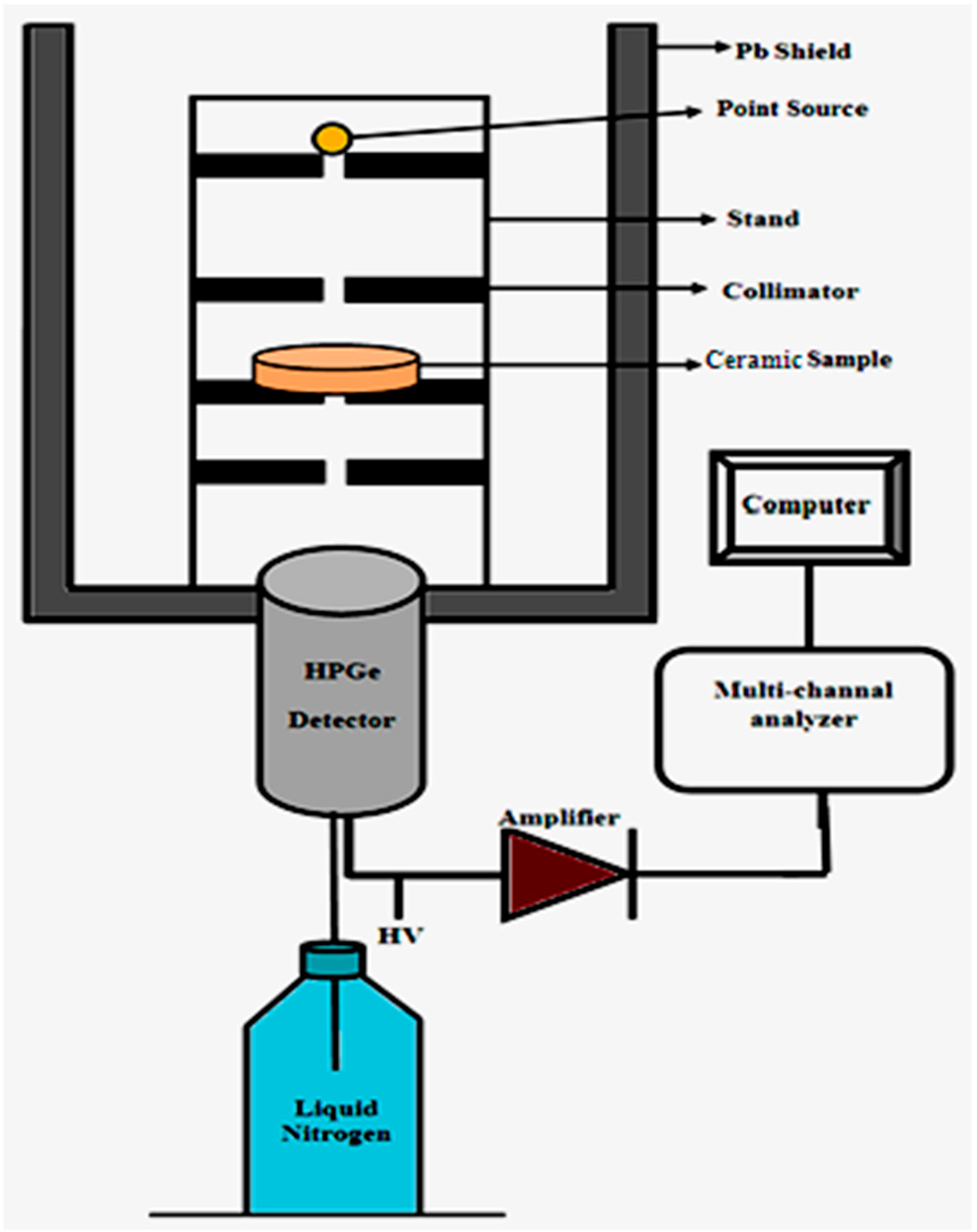

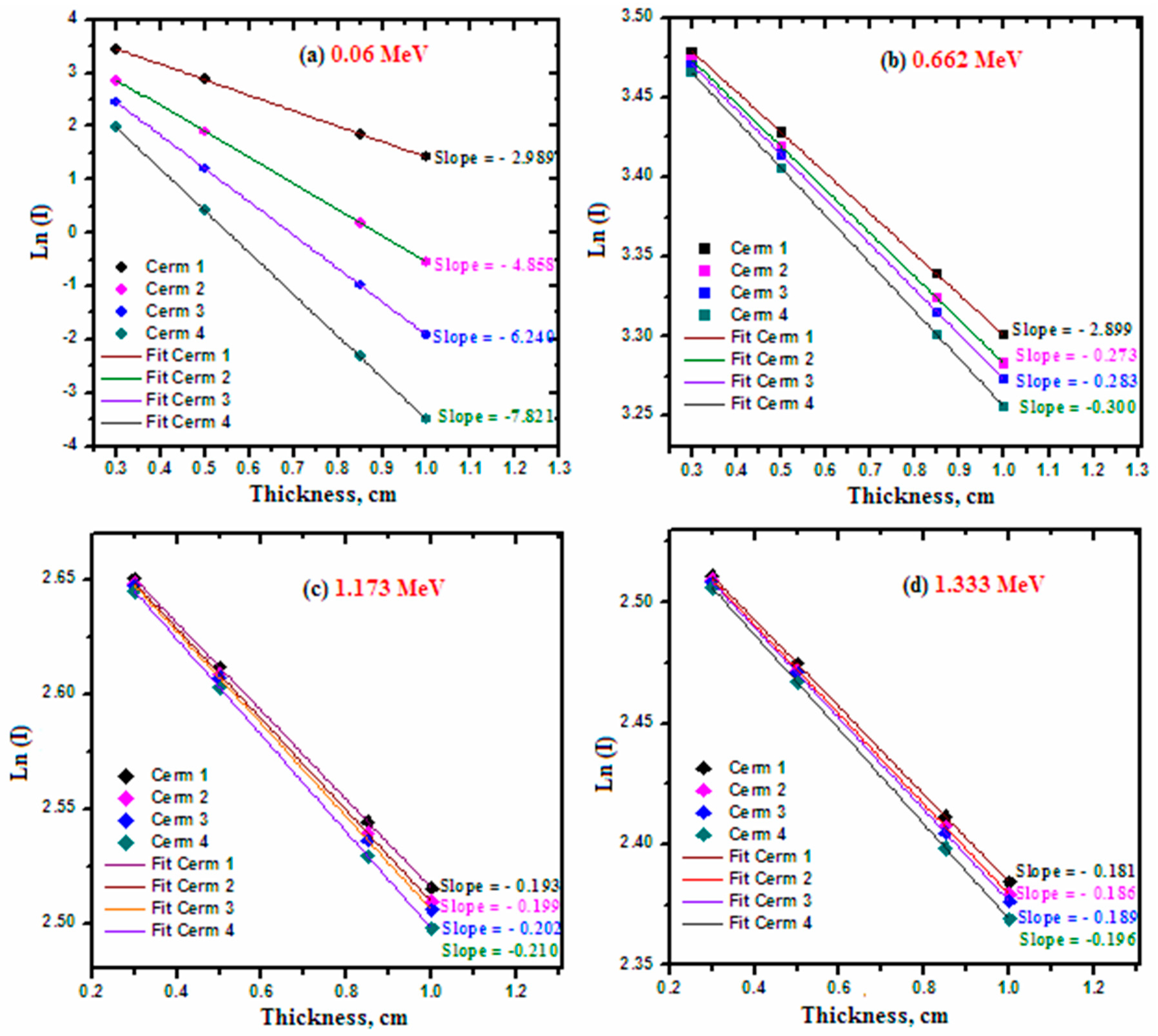
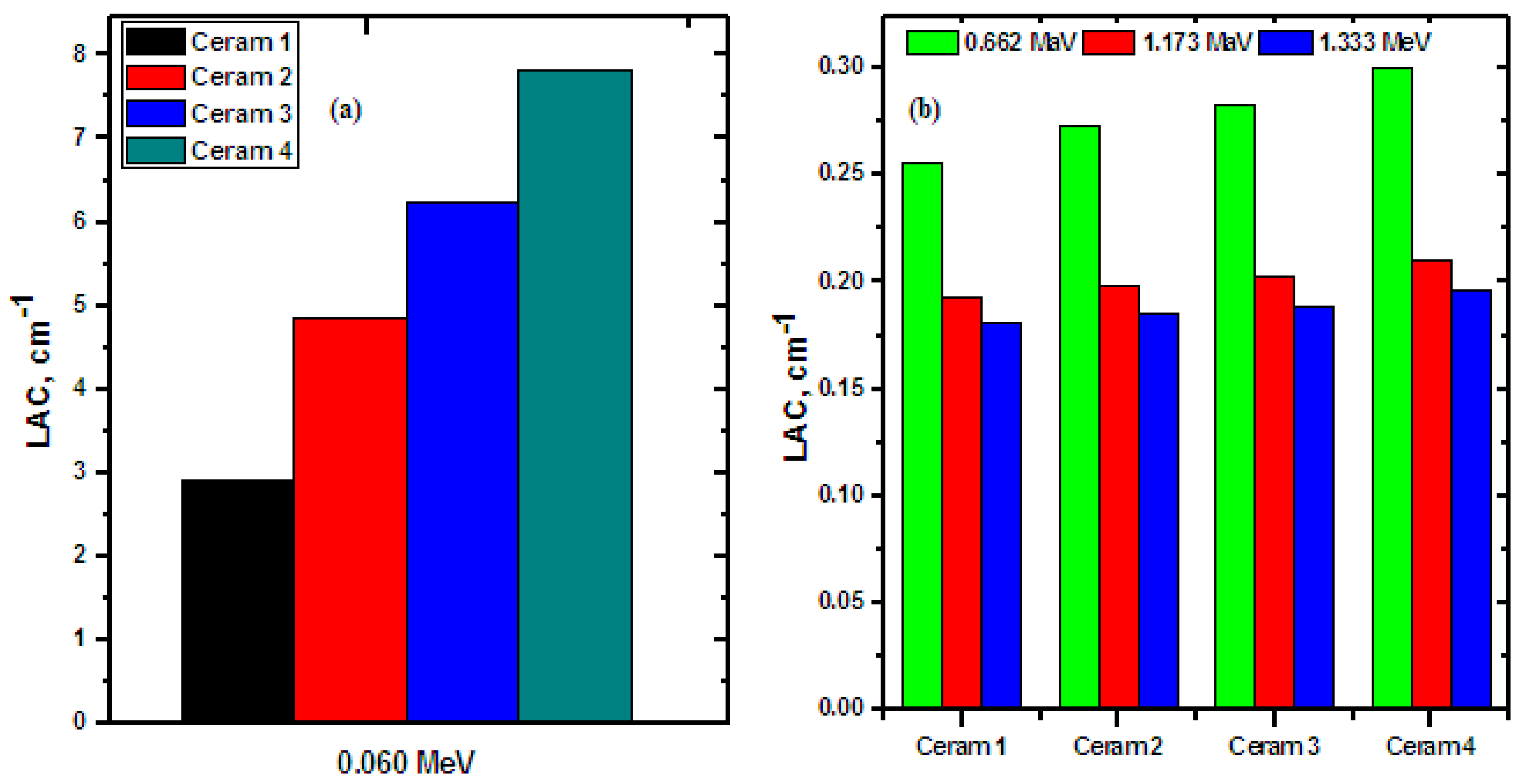


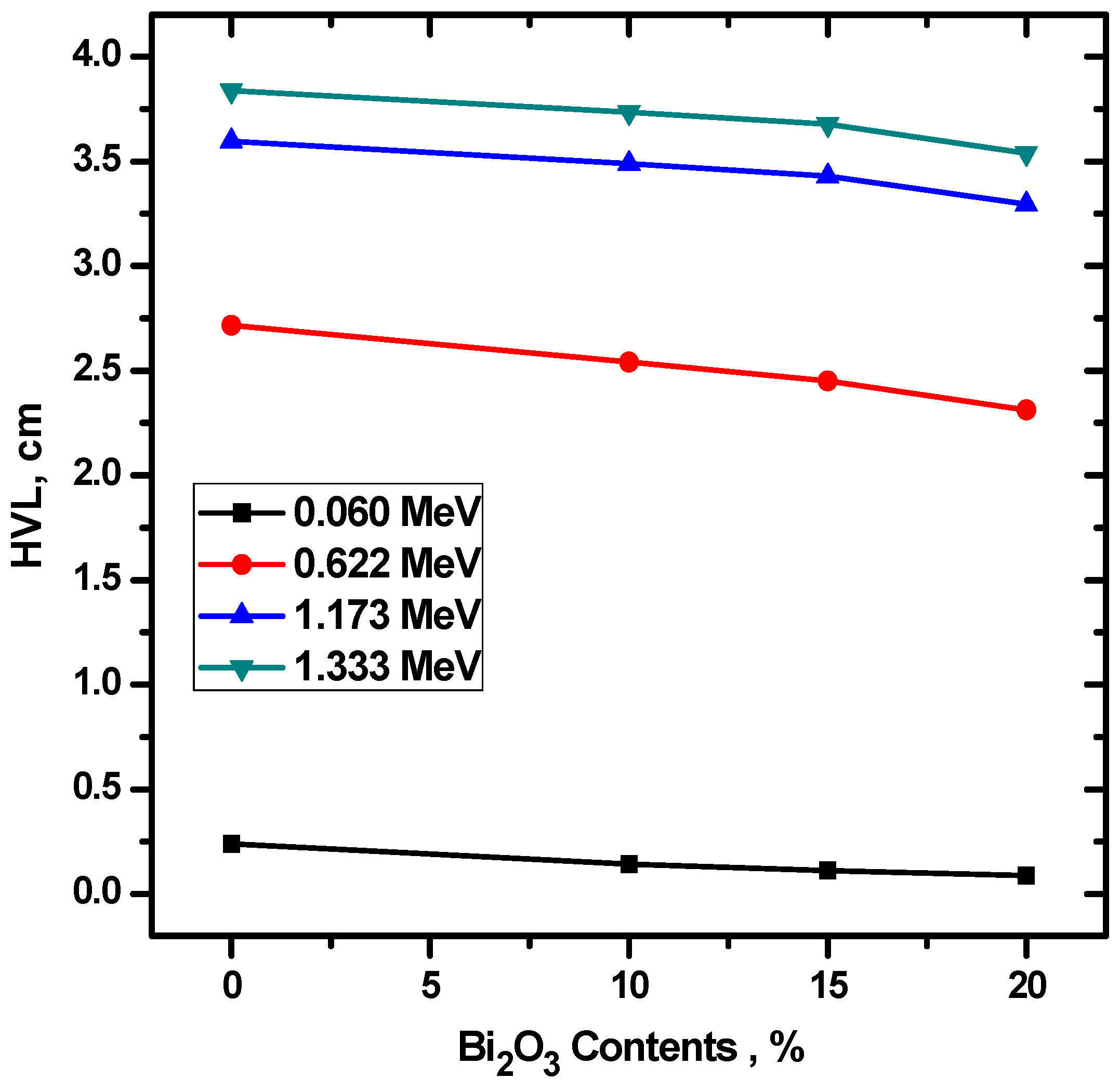
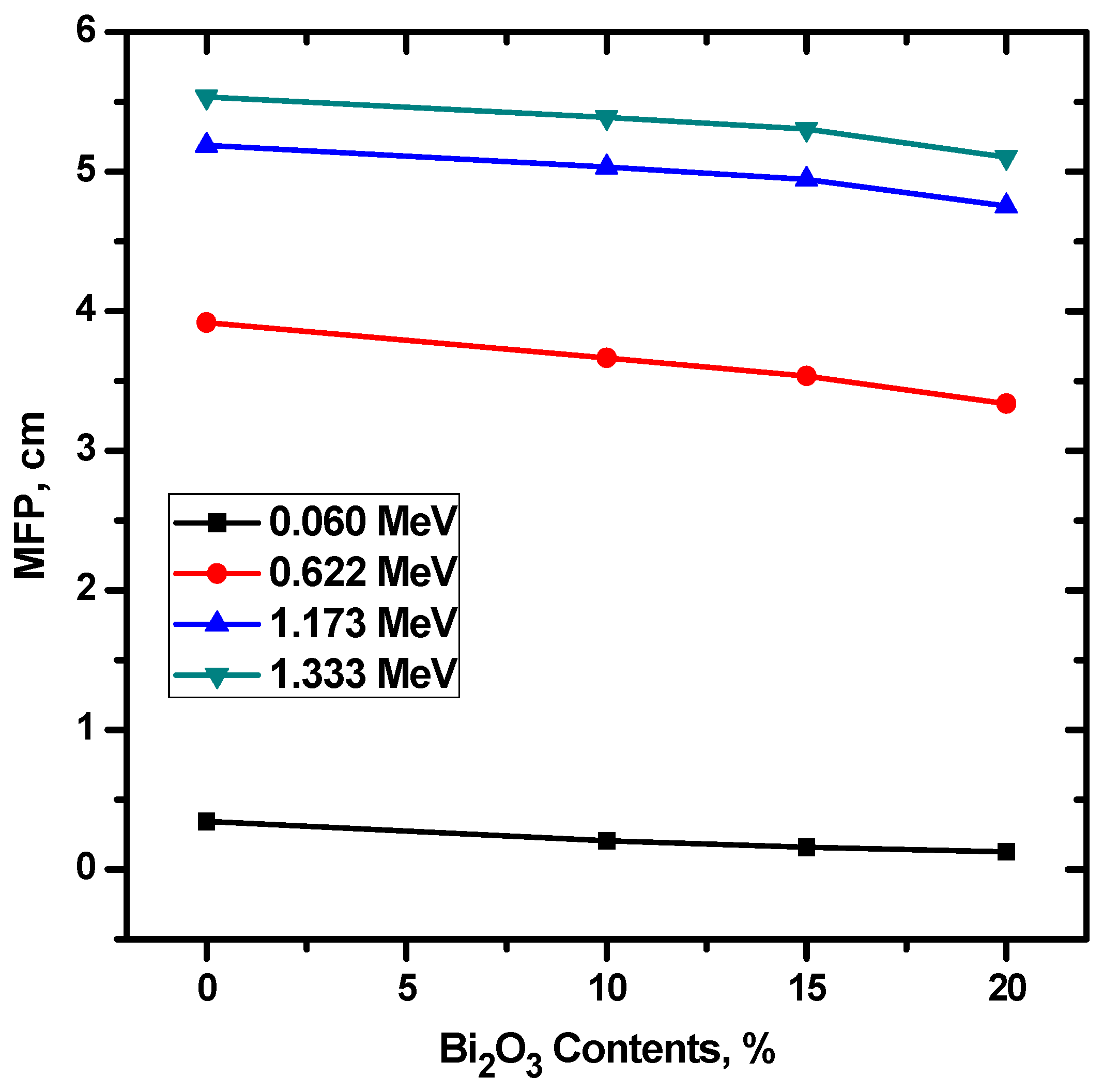

| Oxides | SiO2 | Al2O3 | CaO | Fe2O3 | TiO2 | Na2O | MgO | K2O | SO3 | L.O.I |
|---|---|---|---|---|---|---|---|---|---|---|
| Percentage (%) | 47.65 | 19.35 | 9.92 | 9.62 | 2.54 | 1.27 | 1.18 | 1.18 | 1.66 | 5.63 |
| Sample Code | Compositions, wt (%) | Density (g/cm3) | |||
|---|---|---|---|---|---|
| Bentonite | CuO | CdO | Bi2O3 | ||
| Ceram 1 | 50 | 50 | - | - | 3.398 ± 0.008 |
| Ceram 2 | 50 | 35 | 5 | 10 | 3.465 ± 0.011 |
| Ceram 3 | 50 | 25 | 10 | 15 | 3.509 ± 0.007 |
| Ceram 4 | 50 | 15 | 15 | 20 | 3.634 ± 0.010 |
Publisher’s Note: MDPI stays neutral with regard to jurisdictional claims in published maps and institutional affiliations. |
© 2022 by the authors. Licensee MDPI, Basel, Switzerland. This article is an open access article distributed under the terms and conditions of the Creative Commons Attribution (CC BY) license (https://creativecommons.org/licenses/by/4.0/).
Share and Cite
Al-Ghamdi, H.; Elsafi, M.; Almuqrin, A.H.; Yasmin, S.; Sayyed, M.I. Investigation of the Gamma-ray Shielding Performance of CuO-CdO-Bi2O3 Bentonite Ceramics. Materials 2022, 15, 5310. https://doi.org/10.3390/ma15155310
Al-Ghamdi H, Elsafi M, Almuqrin AH, Yasmin S, Sayyed MI. Investigation of the Gamma-ray Shielding Performance of CuO-CdO-Bi2O3 Bentonite Ceramics. Materials. 2022; 15(15):5310. https://doi.org/10.3390/ma15155310
Chicago/Turabian StyleAl-Ghamdi, Hanan, Mohamed Elsafi, Aljawhara H. Almuqrin, Sabina Yasmin, and M. I. Sayyed. 2022. "Investigation of the Gamma-ray Shielding Performance of CuO-CdO-Bi2O3 Bentonite Ceramics" Materials 15, no. 15: 5310. https://doi.org/10.3390/ma15155310
APA StyleAl-Ghamdi, H., Elsafi, M., Almuqrin, A. H., Yasmin, S., & Sayyed, M. I. (2022). Investigation of the Gamma-ray Shielding Performance of CuO-CdO-Bi2O3 Bentonite Ceramics. Materials, 15(15), 5310. https://doi.org/10.3390/ma15155310








